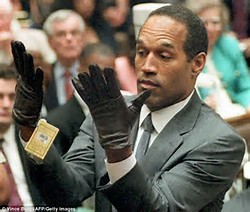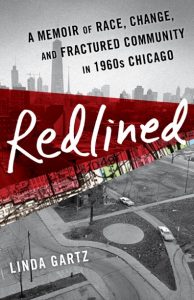I was inspired to write this post by an article in the Guardian by @NatalieYMoore, Chicago’s South Side reporter for WBEZ. (“Don’t let Simpson Blind us to Black Victims of Injustice.”) Last week the focus was on OJ’s parole from prison for the 2008 sports memorabilia robbery. After serving nine years, he’ll probably be released early, from his thirty-three year sentence, in October.

OJ Simpson tries on gloves at 1995 murder trial. Photo by DailyMail.co.uk
It took me back to another October–twenty-two years ago, 1995, when a jury acquitted OJ of murdering his ex-wife, Nicole Brown Simpson and her friend, Ron Goldman. The media were all over the story: Most blacks cheering; most whites were outraged. A large percentage of blacks refused to believe Simpson was guilty. Johnny Cochran’s clever defense strategy convinced many; whites called it “playing the ‘race card’” and most were convinced OJ was guilty.
Many blacks admitted that they believed OJ probably had killed Nicole and Ron. But that didn’t matter. They just wanted a black man to finally “beat the system.”
I was flummoxed. How could these African Americans be cheering for a murderer to go free? What if Simpson’s wife had been black? Why were murders reduced to a cheer? I could not wrap my mind around that idea. Blacks were interviewed and said things like, “You didn’t get a black man this time.” Or “Now you know what it feels like.”
I certainly knew that blacks had been victims of racism at every level of society for decades, but I felt that for that very reason, they should have wanted to see a murderer convicted, even he had been black.
Shortly after the jury found OJ not guilty, we took our two boys for a fall visit to our friends’ seasonal cabin near Sturgeon Bay, WI. It was pretty rural up there 22 years ago—probably still is, so we took a walk down country roads. My boys were nine and four years old. My friend’s daughter was six.
We crunched through fallen leaves under a golden canopy and blue sky, kids running, laughing. As we rounded a corner up ahead, I caught my breath at the sight. An effigy of OJ (the initials printed and pinned to the chest), hanging by its neck from a tree limb. My kids saw it. I was sick.
“That’s horrible!” I yelled out, as they gaped at the human form, swaying in the autumn breeze.
My mind was instantly transported to those disgusting post card photos white people actually had sent to friends. You surely have seen them. Grinning white folks gathered around the swinging body of a black male (some looked no older than fourteen), as if they were at some picnic or celebration; others standing around with serious faces, as if they’d just done a great duty. (I won’t post any of those upsetting photos or even provide a link. You can easily find them if you choose to).
The kids had seen and heard the news about OJ – the nine-month trial had dominated the media. I doubt they had processed much at their age, but this gruesome sight we’d stumbled upon demanded immediate condemnation.
“People can disagree about OJ’s guilt, but to portray him as lynched! They’re saying that’s what they want to happen to OJ.” I hustled them to turn back the way we came, fearful we might see another hanging effigy, twisting in the wind – and kept talking.
“That kind of murder-hanging a person with no trial, it’s called lynching. It really did happen to LOTS of black men. We don’t want anything to do with that kind of thinking. This is just the most hideous type of racism!” I talked more. They had questions, but that’s enough to give you the basics for a blog post.
That sight hit me so viscerally, it made me think again about the black reaction to the verdict: white point of view vs. the black experience.
Since then, as I’ve researched my book, Redlined, which is about our family’s experience during and after the racial changes in my old neighborhood on Chicago’s West Side, I’ve read a lot more about the history of blacks in America. It’s eye-opening–and often appalling, but I’ve also learned about the strength and kinship of so many black families, making it through frightening, often terror-filled, times.
With this history in mind, I have better insight into what those blacks who cheered OJ’s release in 1995 felt. I still disagree with the cheering. Any way you cut it, two people were murdered, and that’s nothing to celebrate.
But that lynched OJ effigy was a potent symbol of the deep racism– proudly displayed–that still exists in our country. And racism is nothing to be proud of.
Linda’s book, Redlined, A Memoir of Race, Change, and Fractured Community in 1960s Chicago will be published April 3, 2018, by She Writes Press
@SheWritesPress
